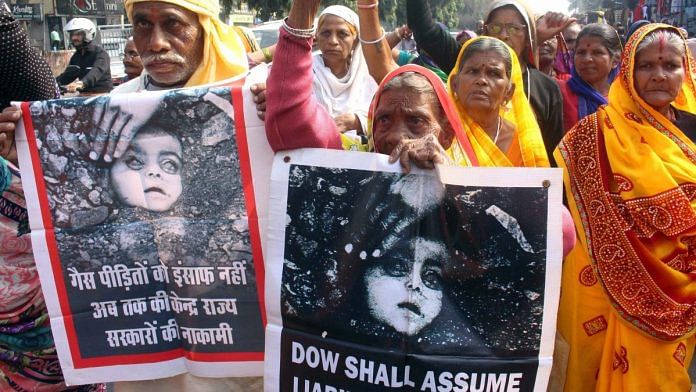For 35 years, Bhopal and its thousands of victims of the world’s worst industrial disaster have waited for justice, often without much hope. Now the Supreme Court of India has a precious opportunity that may never be repeated, to set right a debilitating injustice committed on Indian citizens by not only the American corporation Union Carbide but also its own elected government.
The two colluded to reduce the number and extent of injury that the gas leak caused on the health of the people in Bhopal. Nearly a decade after it was filed by the government of India under intense public pressure, curative petition number 345-347 is now before a constitutional bench of the Supreme Court. The judges must not only set the record straight on the number of deaths – four times more than what the government records have claimed – but also remove the injustice of categorising victim injuries as ‘minor or temporary’ to award compensation.
First thing first
The Supreme Court bench must ensure that the voices of those who have until now been silenced and disregarded are finally given equal hearing before the law.
Union Carbide and Dow Chemical’s lawyers have moved to excise arguments made by survivor groups from the record by contesting their right to even appear in the case. The bench’s first task will be to adjudicate on whether, yet again, to exclude survivors’ voices.
Setting the record right
In 1989, the central government colluded with Union Carbide and the court did the settlement without consulting a single survivor. To make this travesty appear generous, just 3,000 deaths and 30,000 permanent injuries were attributed to a disaster for which a senior city pathologist had signed 10,000 death certificates inside the first two weeks alone.
Among other wickedly false numbers justifying the sell-out were 70,000 temporary or minor injuries. Once the tortuous claims process was over, 93 per cent of the 5,74,376 successful claimants were categorised under ‘minor or temporary’ injuries and awarded a pitiful compensation of $494 each.
Survivor organisations have presented documentary evidence that this temporary/minor injury category was first included in a scheme proposed by Union Carbide vice-president Rolf Towe through secret settlement negotiations that took place mere weeks after the company’s majority-owned factory had turned old Bhopal into a gas chamber. Unbeknown to India’s negotiators, 10 years before this proposition, Carbide’s internal safety report had concluded of exposure to methyl isocyanate (MIC) gas that ‘permanent residual injury is likely in spite of prompt treatment’.
Also read: These documents show how India and Union Carbide colluded on the Bhopal Gas tragedy
The unjust category
Almost four decades on, the reality of this assessment has been continuously proven, day after day, in the queues that still snake into rehabilitation hospitals. Over half a million were treated for chronic, persistent illnesses in 2002 alone. Yet the government’s petition still seeks between $629 million and $1.2 billion in additional compensation for 4,66,293 more injured, every single one of whom it categorises as those with ‘minor or temporary’ injury.
The sole submissions evidencing the reality of permanent injury are those by survivor organisations. They cite India’s apex medical research body and official records to urge recognition of at least 22,917 deaths until 2010 – four times the number claimed by the government.
Also read: The lazy way to remember the Bhopal Gas tragedy
The survivors’ tale
It would take one hundred epics on the scale of Homer’s Odyssey to begin to describe the tribulations of Bhopal’s half a million gas leak survivors. Take the story of Kailash Pawar, whose mother died saving him that night and who lived on with ruined lungs, unable to work, a burden on his family, his hopes constantly rising only to be subsequently dashed, the due redress his family was cruelly denied and who, weeks after the 1989 sell-out, set himself on fire.
Or that of Sunil Kumar, orphaned that night, who woke up in a pile of corpses about to be dumped in the Narmada, who was taken to a New York court to be paraded as a victim, who led a children’s campaign for justice, and who, 22 years after the gas leak, finally succumbed and hanged himself wearing a t-shirt that said ‘no more Bhopal’.
Or that of Hazra Bi of JP Nagar – where the gas was 15,000 times beyond safe levels, where every family suffered losses and where 91 per cent were categorised as suffering minor injuries. She spent decades caring for her gas-exposed sons, walked twice to Delhi to make the prime minister listen, and who lived and died in poverty weeks ago, becoming yet another unseen victim of the Bhopal gas tragedy.
These lives, and tens of thousands more, will weigh upon every step of the proceedings beginning Tuesday.
The Supreme Court may get swayed by the stature and skill of the advocates hired to convince it of the established theories at scandalously huge expense. Or the judges may look at the people who were deceived and cheated by the American corporation and the Indian government. It may think more deeply upon the spirit of the law, and overturn one of the most shocking iniquities of post-Independence India – even of modern peacetime history. In doing so, it would bring to thousands who have long been abandoned some degree of dignity, some sense of justice.
The author is an activist with the Bhopal Group for Information and Action, which has been working with the survivors of Union Carbide gas disaster from 1986. The Bhopal-based voluntary organisation works on all research, publications and campaigns in support of the survivors’ struggle for justice. Views are personal.






